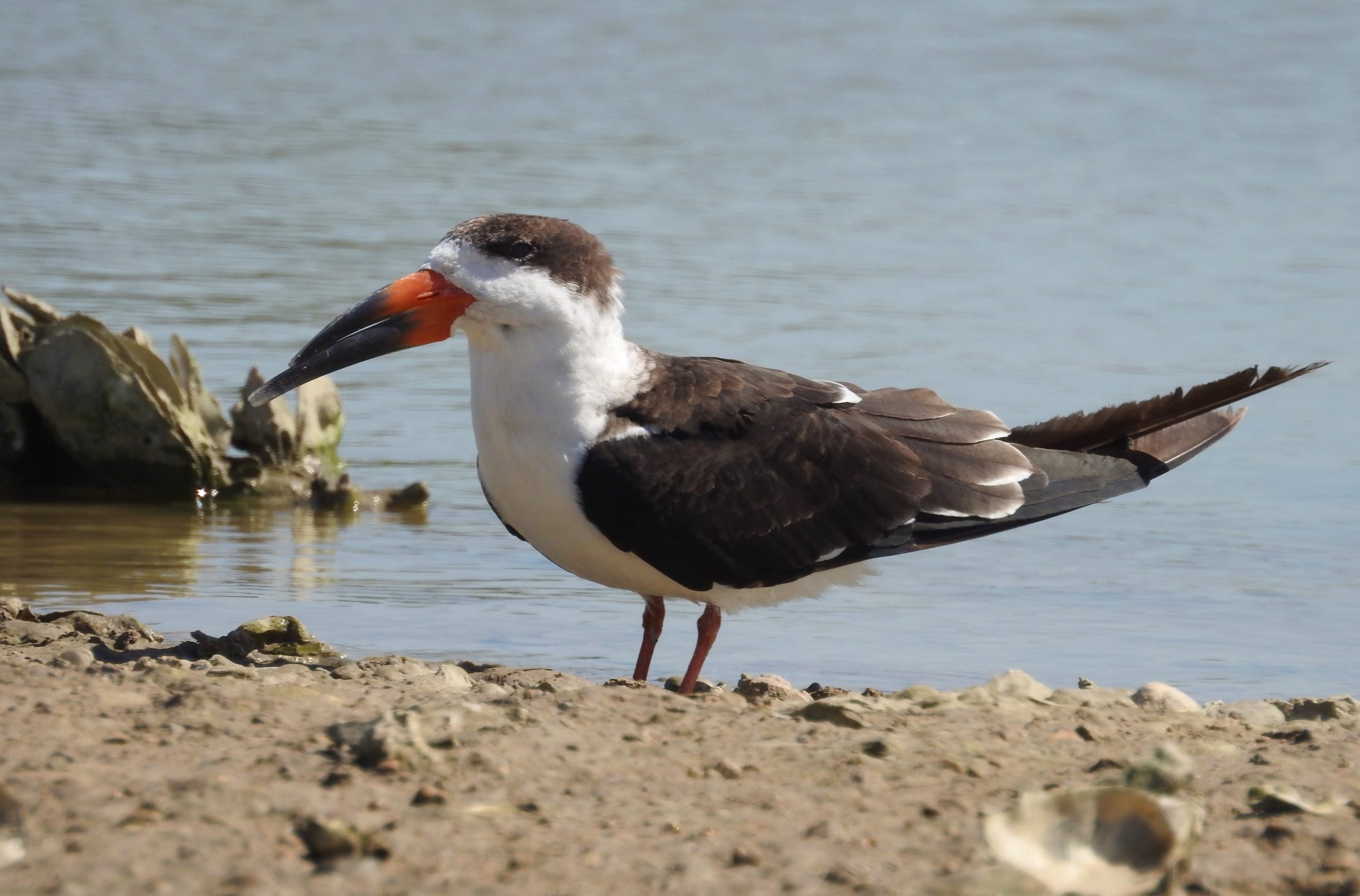by M. Kathy Raines
A slowly curving line, like the groove of an ice skate, invisibly traced the nighttime resaca. A glance upwards revealed the artist—a strange night bird, its massive lower beak slicing through surface waters.
This handsome, distinguished fellow was a black skimmer, the only skimmer in our hemisphere and one of three species worldwide. Its huge, black-tipped red beak leads a boat-shaped body, with black feathers above, including a cap, and white below. With its outsized lower mandible—nearly double the top one’s length—the bird skims off little fish as with a spatula. Skimmers have short legs and, uniquely, vertical pupils—slits that appear to decrease glare from water and sand.

Skimmers launch themselves over calm waters—usually near dusk, dawn or at night—wheel gracefully on long, slender wings and, scissor-like, furrow the surface with their lower beaks. When it strikes a fish, a skimmer’s bill snaps shut, sometimes audibly, with its powerful head and neck muscles absorbing any shock. It either maneuvers the fish to swallow headfirst or carries it crossways to its nest. The skimmer doubles back to retrace its furrow, picking off curious minnows lured to its wake. It eats an assortment of small fish and crustaceans.
Names abound for the black skimmer (Rynchops niger), including shearwater, scissorbill and razorbill. Spanish-speakers call it arador (ploughman), pico de tijera (scissor points) ravado Americano (American skimmer) or cortaguas (cut the waters). Its scientific name comes from the Greek rhunkhos, for “bill” or “face” and Latin niger, meaning “black.”
Black skimmers thrive near and along Atlantic and Gulf coasts from Maine to South America. They may also stray inland, especially after summer storms.

Generally monogamous, new pairs may fly together, fluttering upwards, circling their nesting areas. They often strut through the vicinity, bills upwards and necks extended. Males guard mates from interlopers, raising their heads upward, standing straight or facing downward with a cocked tail. Sometimes the male makes a barking call or opens his bill to reveal a red gape, or open mouth. The wooing male may offer fish to his mate.
Skimmers, highly sociable birds, nest in noisy colonies of perhaps thousands along beaches and sandbars. A couple quickly scrapes out a nest, kicking sand back with alternate feet. Then the birds rotate their bodies, creating a roundish, inch-deep depression. Both incubate the three-to-five eggs, which hatch in about three weeks.
Hatchlings, which have equal-sized bills, readily gobble up the regurgitated fish parents drop for them on the ground. Skimmers’ lower mandibles do not elongate until they’re nearly grown.
Skimmers often stretch themselves flat on the ground, heads downward. This not only cools them, but presumably rests neck muscles tasked with carrying such sizeable bills. In large flocks, skimmers preen together and nap on foot, bills facing the same direction, with outside birds watching for predators. While flying, flock members may turn in unison, wings beating in sync.
The North American Breeding Bird Survey reports that black skimmer populations have decreased 4% per year between 1966 and 2015, a total decline of 87%. Culprits include chemical and oil spills, vehicles, pesticides, storms and rising sea levels, as well as stray pets and natural predators like raccoons and raptors. The 2010 Gulf oil spill resulted in 263 dead skimmers collected that year alone. Also, an increase in human activity, especially in their nesting areas, can hinder success. Alerts are out, and various groups are monitoring these graceful beauties, seeking to undo and mitigate any damages.

